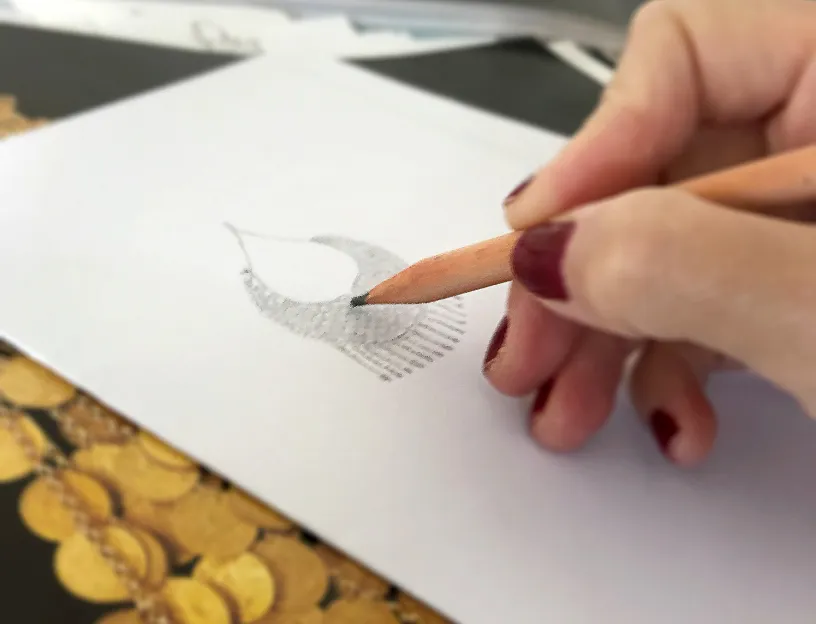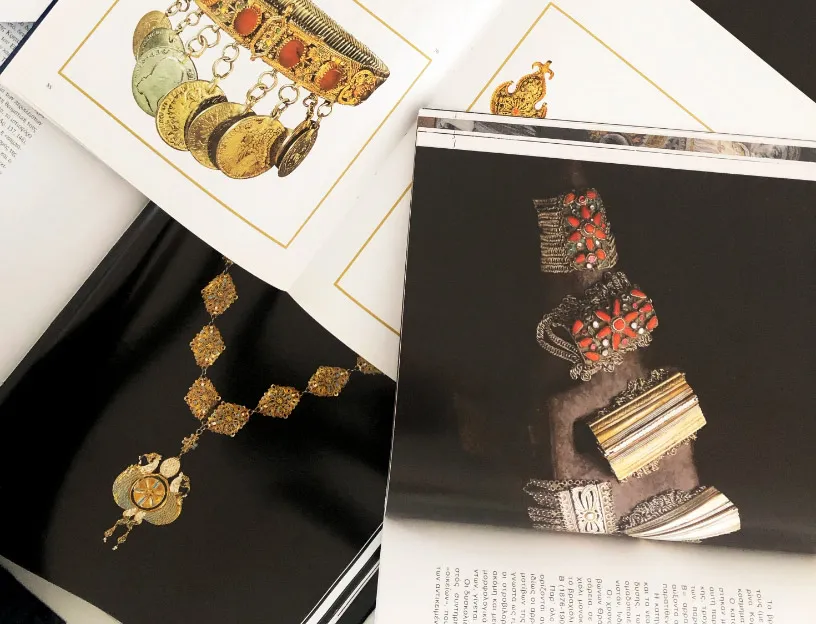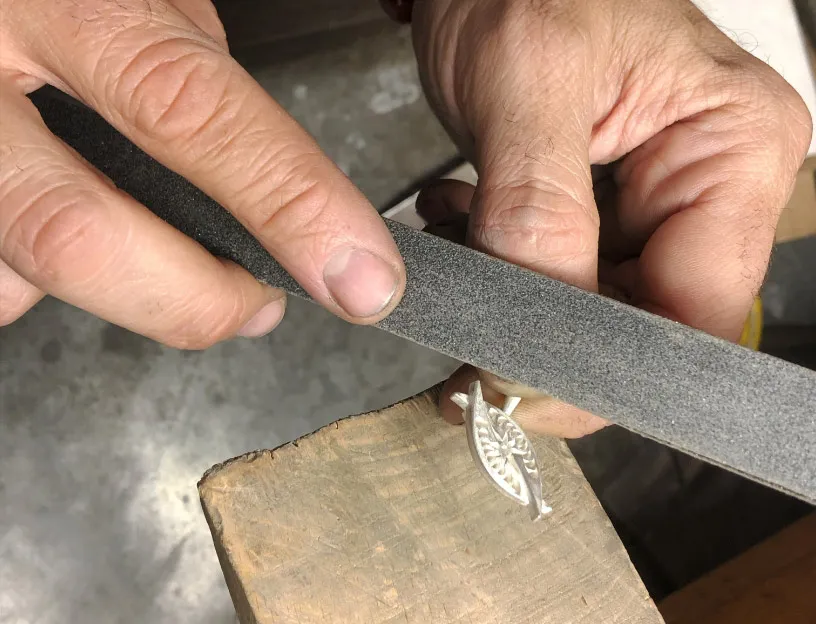THE CONTEMPORARY REVIVAL OF NEO-HELLENIC JEWELRY: THE STORY OF AENÁLIA
- Portes Magazine
- Nov 24, 2024
- 7 min read
Updated: Nov 25, 2024

In the intricate world of cultural revival, AENÁLIA stands as a testament to the timeless allure of Greece’s artistic heritage. Founded by a Katerina Kritikou, the brand reimagines Hellenic aesthetic with contemporary elegance. Inspired by her grandmother’s passion for traditional folk costumes and jewelry, Kritikou embarked on a journey that began in Parisian streets, wearing heirloom pieces that sparked curiosity and admiration.
Today, this unique fusion of East and West, inspired by a deep appreciation for Greece’s post-Byzantine silversmithing techniques from the Ottoman period, is brought to life in collections that honor the past while redefining present-day elegance. At the heart of AENÁLIA is a mission to connect people to stories—of resilience and artistry—through every meticulously crafted piece.
"It’s the fusion of western and eastern patterns that makes neo-Hellenic jewelry so attractive, unique, and playful."
By reimagining a lesser-known chapter of Greek cultural history, Kritikou invites people to rediscover the elegance and artistry of neo-Hellenic jewelry. In this Q&A with Portes Magazine, she shares the journey behind AENÁLIA and the inspirations that continue to shape her work.

What inspired your journey to “open a door” to the revival of neo-Hellenic jewelry, and what was it about your heritage that first ignited this passion?
While aiming at acquiring a strong academic background and experimenting with different professional fields, my persistent desire was to revive a certain period of the Greek jewelry history with which I was closely connected since my childhood. What began as personal research became a vision and finally, since 2019, a business venture. AENÁLIA is the first Greek brand that focuses on the contemporary revival of neo-Hellenic jewelry which formed an integral part of Greek traditional costumes.
My grandmother was a member of the local department of the Lyceum Club of Greek Women, so I was surrounded by tradition since my childhood. She introduced me to the magical world of neo-Hellenic jewelry. I owe my appreciation and love for it to her. She is a great lover of Greek traditional costumes and often traveled around Greece in search of new costumes and jewelry pieces. She even had her own collection of original neo-Hellenic pieces which she gifted to me when I was a teenager.
Some years later, I started wearing them on the streets of Paris where people from all over the world used to ask me where they came from. It was then that I came up with the idea of giving new life to them. My grandmother is the woman that inspired me the most and still encourages me to follow my dream.

Tell us about the specific historical research that informs AENÁLIA’s collections. How do you select and reinterpret traditional elements while ensuring authenticity?
I strongly believe in adaptability and continuity as ways to survive in real life as well as in art. That’s the key element of my vision and the driving force behind every new design. Inspired by the rich heritage of silversmithing tradition during the post-Byzantine period, as well as the remarkable variety of its creations, each AENÁLIA piece is rooted in its cultural context, meticulously designed and handmade with the greatest respect for traditional techniques.
Historical research is of paramount importance for the creation of the collections. Books, articles, exhibition catalogues but also visits to museums and private collections are the cornerstones of my research. After conducting research comes the design process. Selecting a particular part of an original piece, adjusting the design to become wearable, adding a little twist with respect for the traditional pattern. That’s my way of dealing with the challenge of redefining neo-Hellenic jewelry as part of present-day elegance.
It is worth mentioning here that Aggeliki Chatzimichali is an emblematic figure of folk art and tradition. She was the first Greek folklore expert who spent most of her life traveling across Greece during the early 20th century with the aim of preserving folk art. Her extensive documentation is imprinted in a vast bibliography which is my Bible, a valuable source of information and inspiration. A woman of such incredible strength and clear vision will never cease to inspire me.
Neo-Hellenic jewelry uniquely combines influences from the European West and Islamic East. How do you approach this fusion in your designs, and what does it mean to you personally?
It’s exactly this fusion of western and eastern patterns that makes neo-Hellenic jewelry so attractive, unique and playful. I feel that now, more than ever, the world is in desperate need of peace, unity and intercultural encounters. It’s a matter of survival, not a matter of choice. The cultural and creative industries can play a decisive role in raising awareness. Art, design, fashion are extremely powerful and can successfully use their “soft power” to make a change.
What makes neo-Hellenic jewelry so distinctive from other forms of jewelry?
First and foremost, the time period from which it originates. Neo-Hellenic jewelry spans across a broad range of time (17th-late 19th century), space (mainland and the islands) and styles and formed an integral part of Greek traditional costumes, mostly of bridal attires. It was the aesthetic result of very turbulent and oppressive times – when Greece was under Ottoman rule – but at the same time of culturally rich ones. The present-day Greek territory was then a melting pot of western and eastern styles, cultures and traditions. Hence the very unique and interesting jewelry creations that nowadays we call neo-Hellenic jewelry.
"Historical research is the cornerstone of my work, ensuring every design respects the past while embracing the present."
You’ve noted that wearing neo-Hellenic jewelry connects people to a story. Could you share one story from your collections that has special significance to you?
A contemporary woman who is comfortable in her skin and feels special would choose to wear an AENÁLIA piece not only because it is beautiful but also because it has a story to tell, it has roots. I would like to give her the opportunity to feel connected with neo-Hellenic tradition and become a part of its contemporary version.
Each piece has a special story filled with symbols. The story behind the Feres earrings and ring is very dear to me. They are inspired by the “engagements”, a type of bracelet worn in Thrace and generally in the Balkans during the neo-Hellenic period. This particular ceremonial jewelry characterised by the prominent rosettes reminiscent of the female breast, was worn by local women from their wedding day until the birth of their first child. It was believed that this bracelet would increase their fertility.
What role do you see neo-Hellenic jewelry playing in contemporary Greek culture and in the global art and fashion scene?
As an art historian, I have always wanted to dive into Greek history. It was clear to me that I wasn’t so interested in Ancient Greece and the world-renowned Grecian style. Successfully revived by legendary Greek jewelry makers such as Lalaounis and Zolotas, as well as by iconic fashion labels like Dior, the ancient Greek style is considered synonymous with Greece. I strongly believe that this perception is extremely limited and unfair. Given that Greece has a long history, Ancient Greece is just a part of it. An undoubtedly important one. That’s why I will always struggle to give as much visibility and prominence as possible to neo-Hellenic tradition. AENÁLIA is the ideal ambassador.
What is your greatest challenge in launching a jewelry brand?
First and foremost, defining the identity of my business was a necessary condition to get my project off the ground. It demanded a lot of inner strength as well as a strong belief in my dream. The redefinition of neo-Hellenic jewelry, as the main aim of my project, is an ongoing challenge for me and it will always be. It involves in-depth knowledge of the neo-Hellenic tradition and a highly critical eye to revive it in an appealing and contemporary way without losing its distinctive character.
So my biggest challenge is at the core of my business’ identity and I have to face it every time I create a new piece. Overall, telling the world what neo-Hellenic jewelry is and rescuing it from oblivion is demanding, challenging, yet deeply rewarding. I wouldn’t change it for the world!

What do you enjoy the most about working on AENÁLIA’s collections?
I love every minute of the process. From conducting research to establishing partnerships. However, the moment I take a new piece in my hands is by far the best one. There is a part not only of neo-Hellenic aesthetic but also of myself in every piece of AENÁLIA.
What do you cherish most about your Hellenic roots, and Greece as a country?
I enjoy walking around every Greek city, village or island for hours exploring its contrasts and feeling its vibrations. I especially love old neighborhoods where I can find small shops owned by craftsmen that against all odds are still creating masterpieces with their hands.
I have a strong appetite for stories. Every well-preserved or abandoned building, every little road, every square in Greece has a story, and the only ones who know these stories are the locals, especially the old. Chatting with them is very important for me because I believe that stories give meaning to our surroundings.
As I live and work in Athens, I particularly enjoy its art scene. The city bustles with artistic activity every single day. Nothing like Paris, London or New York, though. It’s a very unique art scene formed by an unstable political and financial reality that constantly inspires artists. With one foot in the West and the other in the East, Athens is a very attractive destination for international artists.
Furthermore, I feel extremely privileged to live in the birthplace of theatre that continues the tradition today with numerous classic and modern productions. There are more than 70 theatres across Athens and most of them perform productions of extremely high quality. Greece will never cease to amaze me!
"I have a strong appetite for stories. Every well-preserved or abandoned building, every little road, every square in Greece has a story, and the only ones who know these stories are the locals, especially the old."
How has your diverse career journey, spanning journalism, art, and museum work, shaped your path to founding AENÁLIA?
My career path is anything but linear. Journalism, art, publishing, events, auctions, jewelry design, to name but a few. After completing my studies in Communication & Mass Media at the University of Athens, I obtained a second BA, as well as a MA in Art History at Panthéon-Sorbonne University in Paris.
My professional experience includes positions in museums as the Museum of Cycladic Art in Athens and the Orsay Museum in Paris, as well as in the fields of auctions, art appraisal services and freelance journalism in France and Switzerland. After my return to Greece in 2015, I worked as a gallery assistant, art advisor and curator, before entering the publishing industry as communications manager and events coordinator.
But the most decisive step of my career happens to be the most decisive step of my life in general. I feel that, both personally and professionally, I found my own voice through AENÁLIA. It took me 10 long years to develop its identity and place it on the market. I believe that this is only the beginning!

View the collection at aenalia.com and instagram.com/aenalia_official
WORDS | Portes Magazine
PHOTOS | Yannis Bournias





























